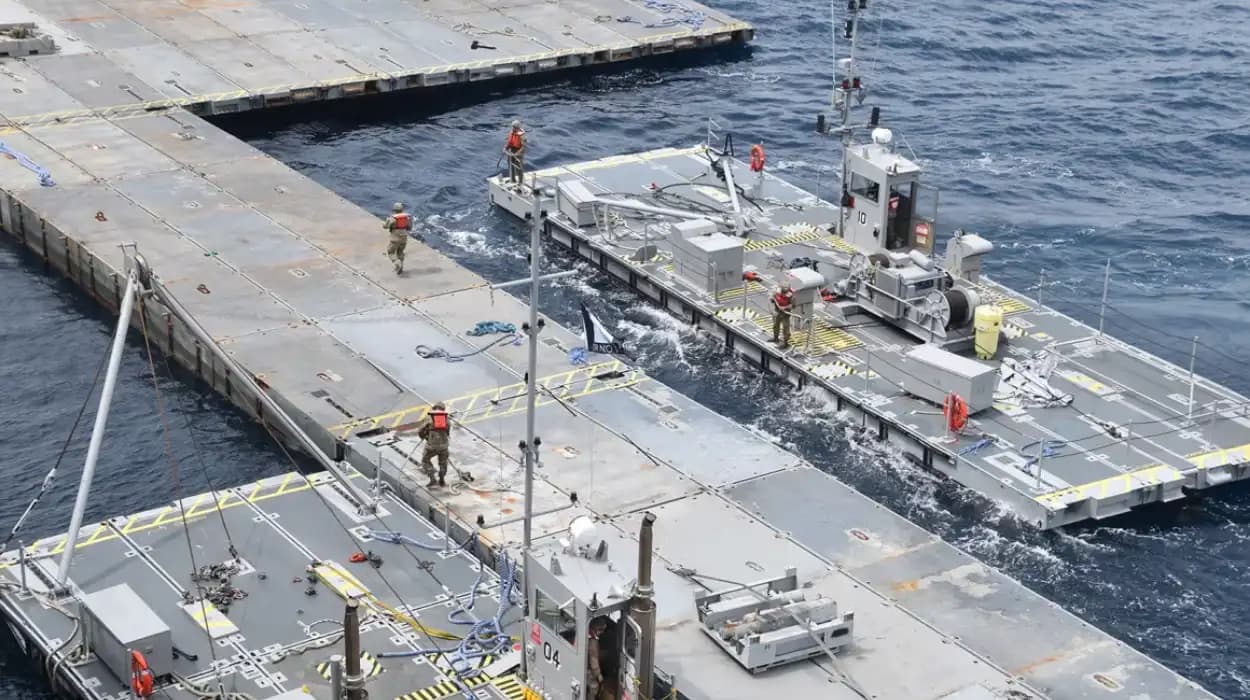The Gaza floating pier stands as a crucial yet controversial
maritime infrastructure project aimed at facilitating the delivery of
humanitarian aid to the Gaza Strip, a region under severe blockade and
conflict-induced humanitarian crisis. Constructed and operated by the United States military, the floating pier was designed as an alternative maritime
assistance route amidst restricted land crossings and ongoing violence.
Background: The Gaza Blockade and the Need for Maritime Aid Access
Since 2007, Gaza has been subjected to a blockade mainly led
by Israel with Egyptian cooperation, aiming to limit weapons smuggling but
resulting in severe economic and humanitarian constraints on the civilian
population. Traditional aid routes over land have frequently been disrupted by
security concerns and military operations, often restricting the continuous
flow of essential supplies such as food, medicine, water, and fuel.
Given these challenges, the idea of leveraging maritime
routes to supplement or bypass terrestrial aid corridors gained traction.
Multiple attempts were made to establish sea-based aid deliveries, including
flotilla initiatives aiming to break the blockade. Ultimately, the United
States proposed and initiated the construction of a floating pier close to
Gaza’s shore as a dedicated platform to facilitate the expedited unloading and
offloading of aid shipments delivered by cargo vessels anchored offshore.
Who Built the Gaza Aid Pier?
The Gaza floating pier was wholly constructed by the United
States military. The project was announced by President Joe Biden in March
2024, with construction commencing early April 2024. Over 1,000 U.S. military
personnel from the Army and Navy took part in building the pier, employing
advanced modular logistics technology known as Joint Logistics Over-The-Shore
(JLOTS).
The construction involved multiple military vessels
including the US Army support ships General Frank S. Besson and MV Roy P.
Benavidez, as well as landing crafts and the Naval Beach Group 1 from San
Diego. The pier extended approximately 550 meters (1,800 feet) into the
Mediterranean Sea and was connected to Gaza’s shore by a modular causeway,
enabling trucks to unload humanitarian assistance. Israeli ground forces
provided security onshore during the construction.
The project cost roughly $320
million and was planned initially as a temporary solution to offload
humanitarian cargo that had been pre-inspected by Israeli authorities at the
port of Ashdod in Cyprus before shipment to the floating pier. Aid would then
be transferred onto trucks for distribution within Gaza, under the coordination
of the World Food Programme and other UN agencies.
Operational Features and Challenges
The pier consisted of two main components: a large floating
unloading platform anchored about eight kilometers offshore and the causeway
linking that platform directly to Gaza’s coast. The pier was designed to handle
approximately 150 trucks of aid daily and to act as a backup or supplementary
aid delivery system during times when land border crossings were closed or
unsafe.
Operational effectiveness, however, was hampered by several challenges:
- Weather
and sea conditions often made operation difficult or forced temporary
dismantling.
- The
pier was susceptible to damage from high seas and required multiple
repairs during its brief operational period.
- Complex
coordination was needed between the US military, Israeli authorities, and
humanitarian agencies regarding inspections and aid transfer logistics.
- The
project faced criticism as an expensive and overly complex solution that
did not fully address the root problems of restricted land access.
Despite these obstacles, the pier facilitated the landing of
approximately 8,800 metric tons of aid during its 20-day operational span from
May to July 2024.
Strategic and Political Dimensions
The floating pier embodies a strategic response shaped by
geopolitical and security considerations. Security measures included anti-drone
defense systems installed along the pier, and operations were conducted
ensuring US troop presence remained offshore, avoiding direct ground
deployment.
The project was partially influenced by a political
imperative to demonstrate US action in supporting Gaza’s humanitarian needs
without altering broader military and diplomatic dynamics particularly
regarding Israel’s control of Gaza’s borders.
Critics have argued that the floating pier served partly as
a public relations effort to sidestep international pressure on Israel to open
land crossings. Additionally, UN agencies like UNRWA were initially excluded
from involvement in the pier’s operations, further complicating humanitarian
coordination.
Who built the Gaza aid pier? The answer is the United States military, employing sophisticated logistics technologies and significant manpower to erect a pioneering floating dock system designed to aid a profoundly besieged population. Constructed quickly and at high cost, the pier represented a unique maritime intervention aiming to circumvent the grave limitations imposed by land blockades. While the pier helped deliver substantial aid, its operational challenges and political complexities highlight the inherent difficulties in resolving the humanitarian crisis in Gaza through engineering feats alone. Long-term solutions remain tied to broader geopolitical negotiations and sustainable access pathways.
